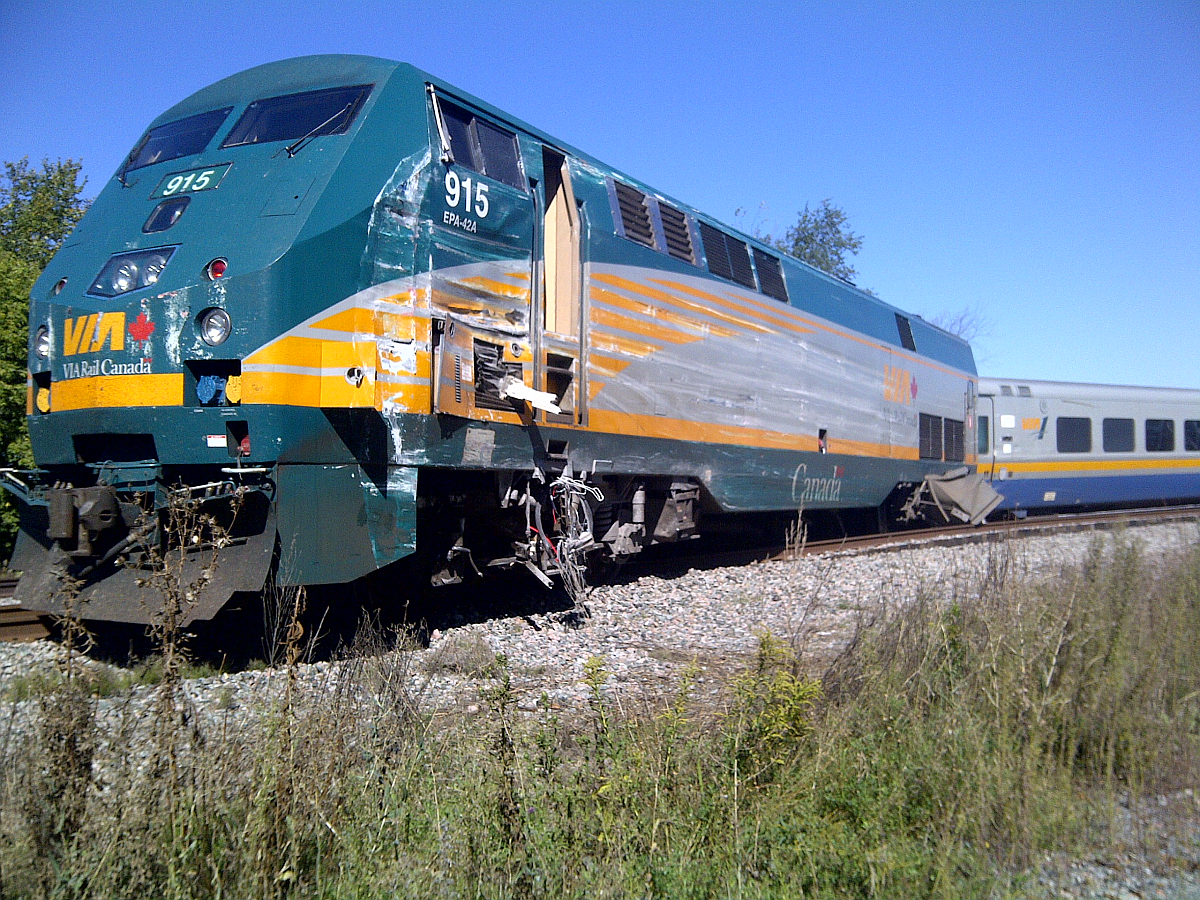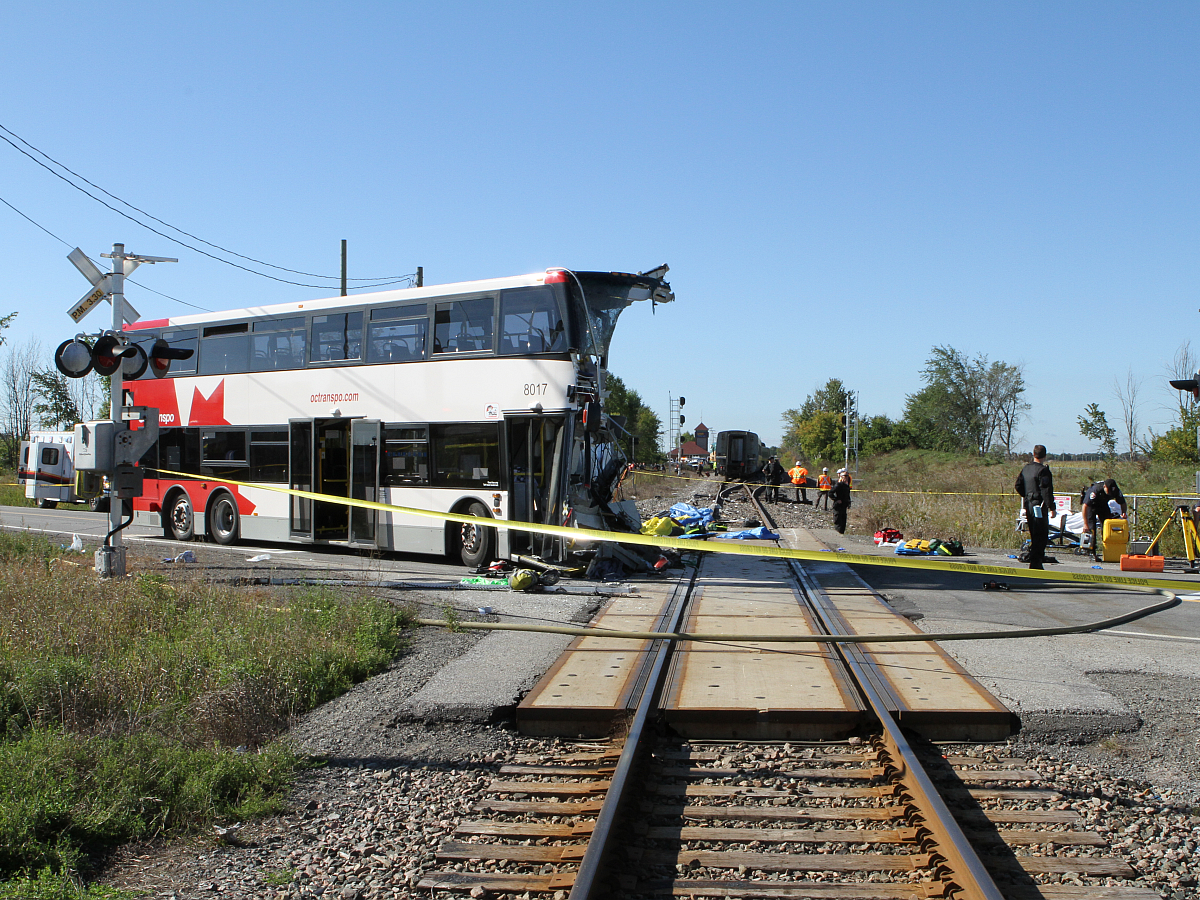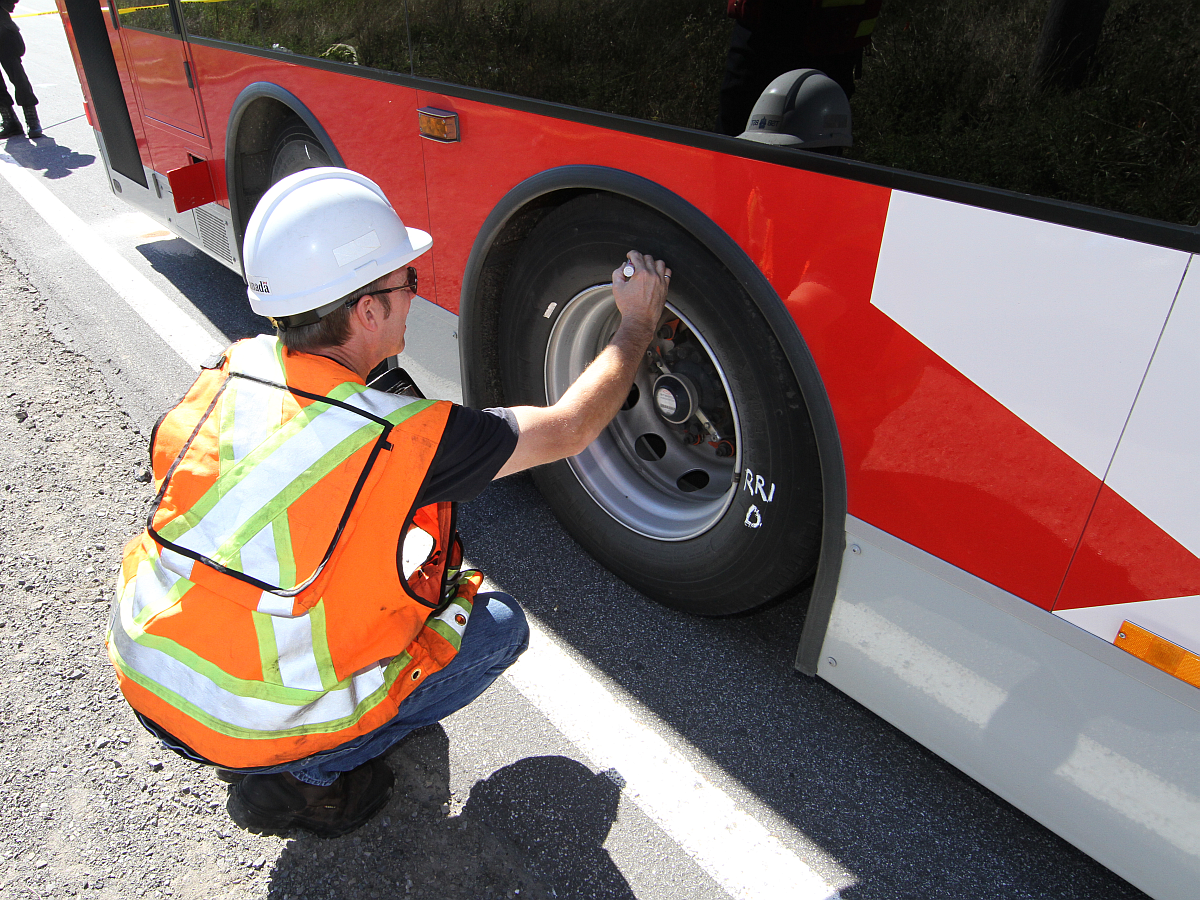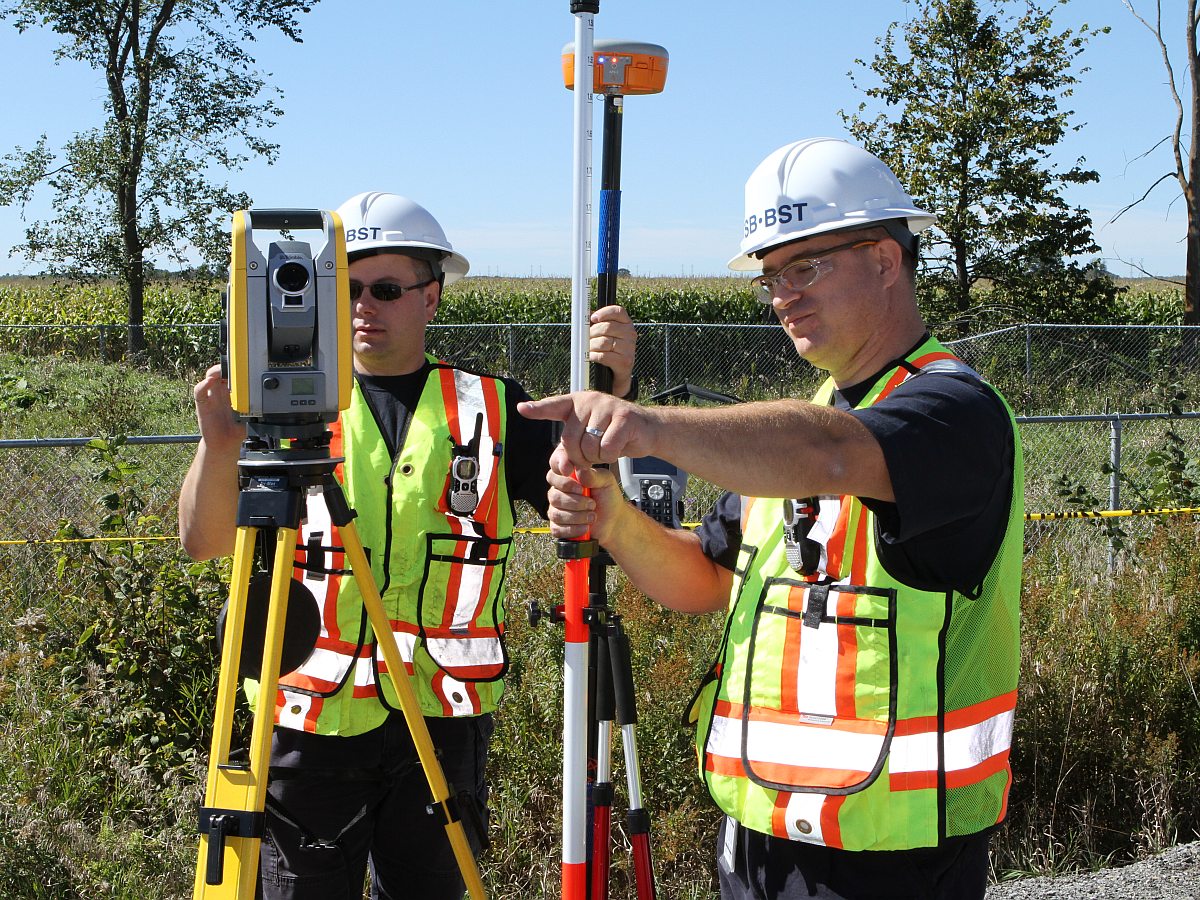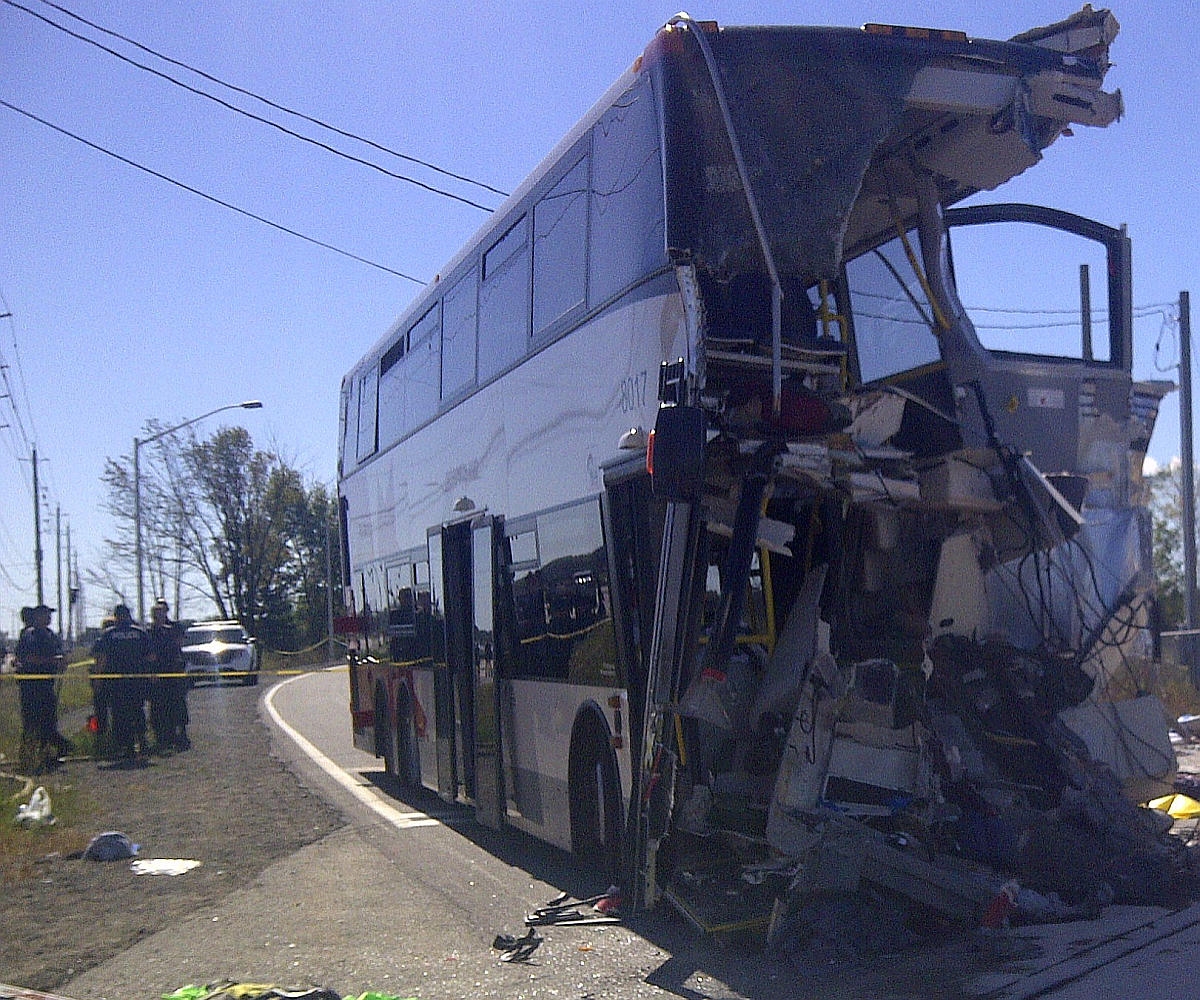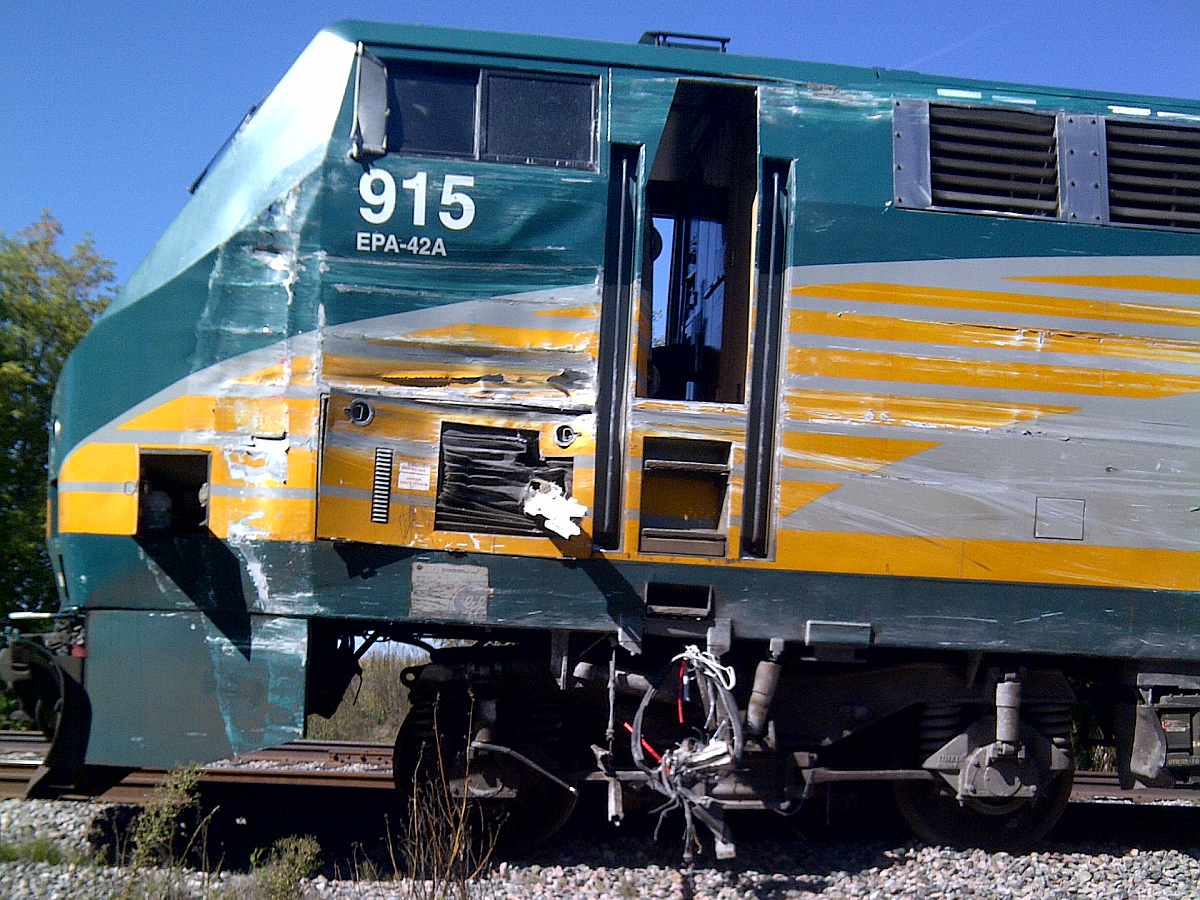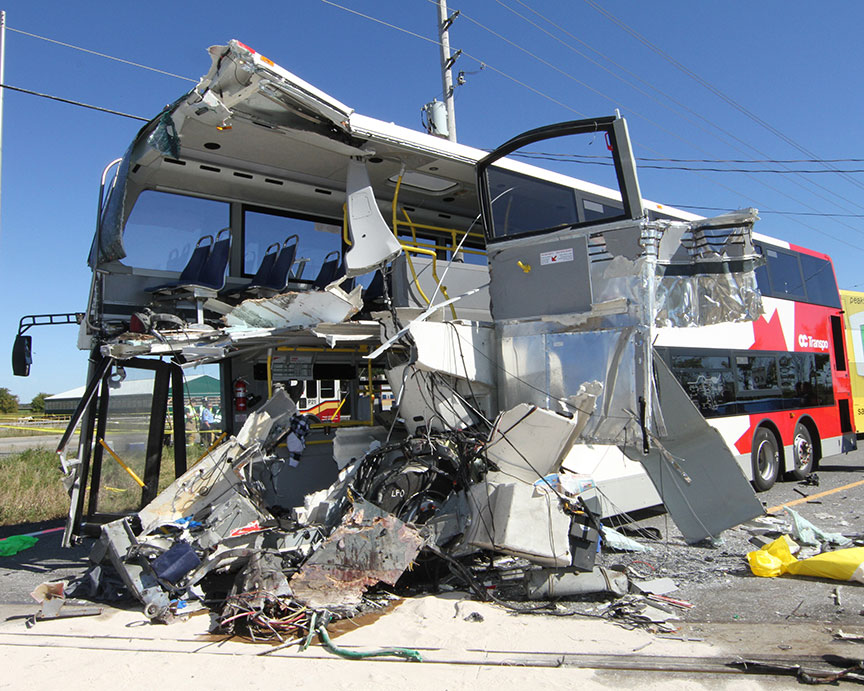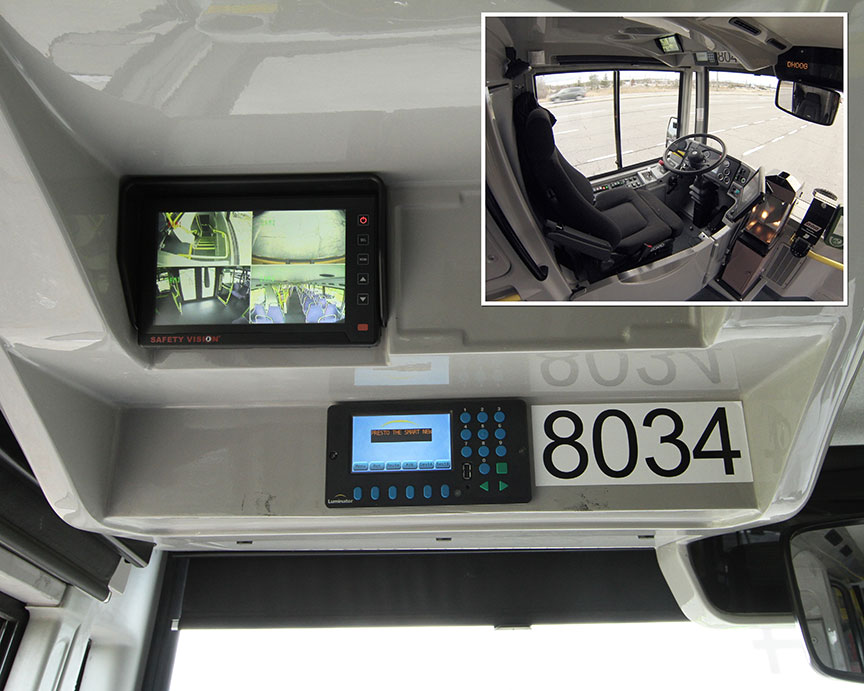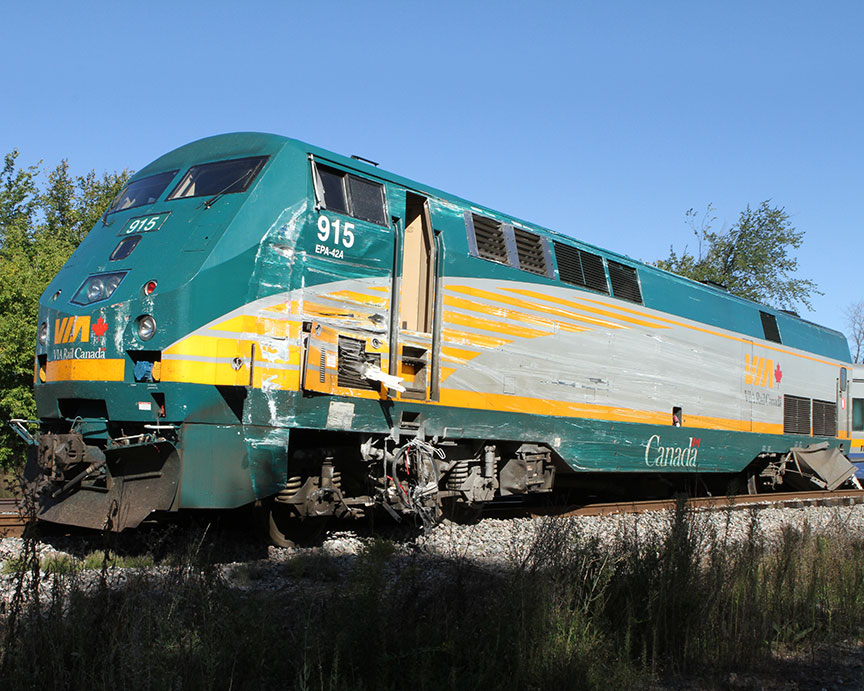Crossing collision
VIA Rail Canada Inc. passenger train No. 51
OC Transpo double-decker bus No. 8017
Mile 3.30, Smiths Falls Subdivision
Ottawa, Ontario
The occurrence
On 18 September 2013, at about 0832 Eastern Daylight Time, westward VIA Rail Canada Inc. (VIA) passenger train No. 51 departed from the VIA Ottawa Station on time and proceeded en route to Toronto. At 0847:27, OC Transpo double-decker bus No. 8017 departed from the Fallowfield Station on the OC Transpo bus Transitway. At 0848:06, while proceeding at about 43 mph, the train entered the OC Transpo Transitway crossing, located at Mile 3.30 of VIA’s Smiths Falls Subdivision. At the time, the crossing lights, bells and gates were activated. The northbound bus was travelling at about 5 mph with the brakes applied when it struck the train. As a result of the collision, the front of the bus was torn off. The train, comprising 1 locomotive and 4 passenger cars, derailed but remained upright. Among the bus occupants, there were 6 fatalities and 9 serious injuries, and about 25 minor injuries were reported. No VIA crew members or VIA passengers were injured.
The investigation
Event recorders
On the day of the accident, investigators obtained downloads from the crossing signal bungalow and the locomotive event recorder (LER) to evaluate the operation of the crossing protection and the train. The bus tires and brakes were visually examined and documented in place. The bus did not have a single event recorder to store vehicle performance and operation data (i.e. black box). However, there were a number of electronic units which contained non-volatile-memory (NVM). These included the anti-lock braking system/anti-slip regulation (ABS/ASR) control module, the central controller, the transmission control module (TCM), the heating-ventilation and air conditioning (HVAC) system memory, the automatic fare recording Presto units, the Intelligent Vehicle Network (IVN) system, Global Positioning System (GPS) data from the City of Ottawa and the Engine Control Module (ECM). The bus battery was disconnected and the engine compartment was sealed to preserve any recorded data. The bus was then transported to a secure location for further examination.
Re-enactment
On 28 September 2013, the TSB conducted an accident re-enactment on the Transitway. The re-enactment was photo and video documented from the bus driver’s station. It was conducted at approximately the same time as the accident and under similar environmental conditions. A few days later, additional testing was conducted at the crossing to record the time it took for various bus types to travel over the crossing after stopping at the north approach.
Sequence of events
A detailed sequence of events was compiled from various sources including the train, the crossing signals, the bus and video cameras at the OC Transpo Fallowfield Station. Some event times for activities that occurred onboard the bus were approximated based on multiple witness accounts of what transpired.
All available data from the electronic units recovered from the bus and containing NVM was downloaded and examined at the TSB Engineering Laboratory. Only the Engine Control Module (ECM) contained any information relevant to the operation of the bus just prior to the accident. However, the information lacked sufficient detail to conduct a meaningful analysis and further work was required to calculate speed at the time of the collision, braking force and the related stopping distances.
Bus braking system
A detailed teardown and examination of the bus braking system was completed. A braking analysis was performed to determine event timing, speed at the time of impact, braking distance and amount of brake force applied to a loaded bus during the accident scenario. The analysis incorporated measurements and observations made on-site and detailed engineering calculations based on ECM data, brake system reaction time, and brake performance charts from both the bus certification tests and manufacturer tests.
Traffic studies and speed testing
Traffic studies were conducted on Woodroffe Avenue, the Transitway and Fallowfield Road. The TSB conducted speed testing in the vicinity of the crossing for vehicles using the Transitway.
Ergonomic study
TSB Human Performance staff conducted an ergonomic study of the driver’s station for each of the bus designs operated by OC Transpo.
Information sharing
As part of data collection and information sharing, the following activities have been ongoing:
- In accordance with an existing Memorandum of Understanding, the TSB and the Coroner have been sharing information in support of each other’s ongoing investigations.
- Numerous interviews have been conducted with survivors, witnesses, OC Transpo staff and City of Ottawa personnel. The TSB continues to conduct interviews as necessary.
- TSB specialists have remained in contact with the next of kin of the victims and have provided them with updates on progress.
What we know
The following is a summary of facts as determined by the investigation so far.
Information known shortly after the accident:
- The bell was activated, but no train horn was sounded due to an existing municipal ban.
- The crew applied the emergency brakes 2 seconds prior to the accident.
- The train was travelling at 47 mph when it was struck by the bus.
- At the time of the accident, the crossing Active Warning Device (AWD) protection operated as intended with no malfunctions.The gates had been horizontal for 26 seconds prior to the accident.
- TSB has not identified any issues with the operation of the train, the operation of the crossing signals or the condition of the track.
Since then:
Bus Operator
- The Coroner’s investigation determined that there was no medical illness involved in the driver’s death and toxicology testing showed no evidence of drugs or alcohol.
Maintenance
- A series of mandatory certification tests had been conducted to verify compliance with the Canada Motor Vehicle Safety Standards (CMVSS). The bus met or exceeded all CMVSS criteria for operation in Canada.
- Upon delivery of the bus, a Ministry of Transportation of Ontario inspection was performed with no exceptions noted.
- The bus was maintained in accordance with the operator’s approved maintenance program.
Braking
- There were no reported brake defects on the occurrence bus.
- There were no mechanical discrepancies identified that would preclude normal operation of the bus air brake system.
- The initial application of the bus brakes occurred when the bus was travelling at a speed of 67.6 km/h (42 mph), which exceeded the posted speed limit of 60 km/h (37.3 mph).
- Full braking force was not initially applied.
- The bus was located 116.8 ft (35.6 m) south of the point of collision when braking was initiated.
- The bus was travelling between 6.4 - 7.7 km/h (4 and 4.8 mph) when the collision occurred.
- TSB calculations indicated that, had the bus been travelling at the posted speed limit (60 km/h) and all other factors remained the same, the stopping distance for the bus would have been 29.5 m (96.8 ft) which would be 6.1 m (20 ft) before the point of collision.
Ergonomic Study
- Within the driver workstation, a small video monitor (6” (15 cm) wide by 3 ¾” (10 cm) high) is located on the left side of a forward panel above the driver seat which creates a significant upwards viewing angle for the driver.
- OC Transpo drivers are instructed not to stare at the video monitor while driving.
- At station stops, OC Transpo drivers are required to view the monitor before departing to ensure that upper deck passengers are seated. If passengers are seen standing on the upper deck, drivers are required to announce that standing is not permitted on the upper deck.
- To find available seating after boarding a double decker bus, some passengers may be moving or standing on the upper deck after the bus is in motion. Under these conditions, to monitor the upper deck, a driver will need to periodically glance at the screen while the bus is in motion. This situation can lead to a driver being visually distracted from the driving task.
Next steps
As the investigation continues, the TSB will:
- undertake further assessment of crossing and roadway alignment including a review of previous grade separation studies;
- review the studies relating to buses stopping at railway crossings;
- continue to analyze what may have influenced driver behaviour and information processing;
- gather and analyze information related to OC Transpo transit operations and bus driver training; and
- conduct a crashworthiness assessment of the bus.
Safety communications
Safety Recommendations
TSB Recommendation R15-01: The Board recommends that the Department of Transport, in consultation with the provinces, develop comprehensive guidelines for the installation and use of in-vehicle video monitor displays to reduce the risk of driver distraction.
TSB Recommendation R15-02: The Board recommends that the Department of Transport develop and implement crashworthiness standards for commercial passenger buses to reduce the risk of injury.
TSB Recommendation R15-03: The Board recommends that the Department of Transport require commercial passenger buses to be equipped with dedicated, crashworthy event data recorders.
TSB Recommendation R15-04: The Board recommends that the Department of Transport provide specific guidance as to when grade separation should be considered.
TSB Recommendation R15-05: The Board recommends that the City of Ottawa reconsider the need for grade separation at the Woodroffe Avenue, Transitway and Fallowfield Road level crossings.
Safety Advisory Letters
Rail Safety Advisory Letter 12/14: Braking analysis and bus speed approaching crossings
Rail Safety Advisory Letter 10/14: Video monitoring system on OC Transpo double decker buses
Rail Safety Advisory Letter 02/14: Reported malfunction of transitway automatic crossing protection
Rail Safety Advisory Letter 01/14: OC Transpo buses traversing crossings with activated AWD protection
Media materials
News releases
TSB assesses responses to recommendations arising from the 2013 OC Transpo-VIA RAIL accident investigation
Read the news release
TSB issues five recommendations following investigation into September 2013 collision between an OC Transpo bus and a VIA Rail train
Read the news release
Progress update on investigation into fatal 2013 OC Transpo – VIA Rail collision on Ottawa’s Transitway
Read the news release
TSB issues safety advisory letters to the City of Ottawa as part of fatal September 2013 bus–train collision investigation
Read the news release
Update on investigation into OC Transpo - VIA Rail collision in Ottawa
Read the news release
TSB launches investigation into bus-train collision in Ottawa, Ontario
Read the news release
Backgrounders
Speeches
News conference for OC Transpo-VIA Rail (R13T0192): Opening remarks
Kathy Fox, Chair, Transportation Safety Board of Canada
Rob Johnston, Investigator-in-Charge
Deployment notice
Transportation Safety Board of Canada deploys team to the site of a collision between a VIA Rail train and an OC Transpo bus in Ottawa, Ontario
The Transportation Safety Board of Canada (TSB) is deploying a team to the site of a collision between a VIA Rail train and an OC Transpo bus in Ottawa, Ontario. The TSB will gather information and assess the occurrence.
Video
Sequence of events of the crossing collision between VIA Rail Canada Inc. passenger train and OC Transpo double-decker bus (R13T0192)
Watch the video
Investigation information
Download high-resolution photos from the TSB Flickr page.
Class of investigation
This is a class 2 investigation. These investigations are complex and involve several safety issues requiring in-depth analysis. Class 2 investigations, which frequently result in recommendations, are generally completed within 600 days. For more information, see the Policy on Occurrence Classification.
TSB investigation process
There are 3 phases to a TSB investigation
- Field phase: a team of investigators examines the occurrence site and wreckage, interviews witnesses and collects pertinent information.
- Examination and analysis phase: the TSB reviews pertinent records, tests components of the wreckage in the lab, determines the sequence of events and identifies safety deficiencies. When safety deficiencies are suspected or confirmed, the TSB advises the appropriate authority without waiting until publication of the final report.
- Report phase: a confidential draft report is approved by the Board and sent to persons and corporations who are directly concerned by the report. They then have the opportunity to dispute or correct information they believe to be incorrect. The Board considers all representations before approving the final report, which is subsequently released to the public.
For more information, see our Investigation process page.
The TSB is an independent agency that investigates air, marine, pipeline, and rail transportation occurrences. Its sole aim is the advancement of transportation safety. It is not the function of the Board to assign fault or determine civil or criminal liability.

